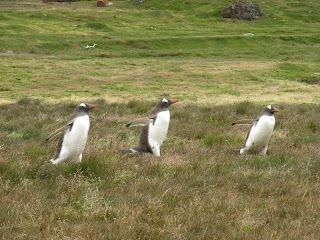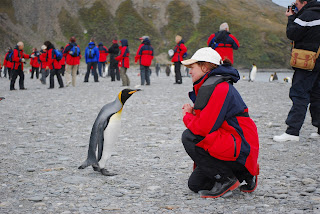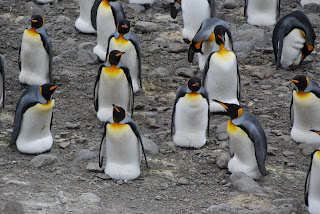






Penguins won our hearts! They are such amazing little creatures! Although defined as flightless birds adapted to life in cold seas, that doesn't begin to tell you of their amazing resilience and beauty in this relatively inhospitable environment. Their dense layer of waterproof feathers provides insulation by trapping air. They are also equipped with a layer of blubber. Each year in the spring, it is necessary to molt; this means "off with the old and on with the new" - feathers, that is - a necessity to maintain the waterproof aspect.
The first photo is of a Chinstrap Penguin at Monroe Bay in the South Orkney Islands.
I probably don't need to explain how they were named! Chinstraps prefer to nest on rocky, steep slopes and are more aggressive than Kings.
The second and third photos are Gentoo Penguins (recognized by the white patch over their eyes and the bright coral bill) strutting across a field at Grytviken, an abandoned whaling station on the Isle of South Georgia. (Visits to this location are allowed after six million pounds was spent to clean it of asbestos and other hazardous materials. Other abandoned whaling stations are closed to visitors within 200 meters.)
Photos 4 and 5 show Macaroni Penguins hopping to their nests high up on the cliffs - very different habit from the Kings who nest on the beach. Macaronis are distinguished by their bright yellow plumes growing in an arch across the center of the forehead. Where most penguins walk, Macaronis hop! It is said they can climb 200 M (656 feet) in 20 minutes.

Guidelines for our behavior in Antarctica are set out by IAATO (the International Association of Antarctic Touring Operators). Many are obvious , such as no littering or trampling vegetation, and although we were not allowed to approach within 15 feet of penguins, the penguins were unaware of the rules and were often curious about us, getting quite close to check out the "redcoat invaders".

A fluffy little chick (scientists refer to these guys as "Oakum Boys" ). The young of each of the species has it's own characteristics and habits.

King Penguins, endowed with vivid colors, were the most beautiful of the species we met.

Tete a tete! Paired birds dedicate themselves to the birth and nurturing of their young. Their musical, bugling cadence helps to locate their mates in the mass of birds on shore.


You have to love a guy that will hang around for the boring part..........and these little fellas definitely carry their share of the parenting burden! Hours after the female lays the egg, the male takes the egg from the female, carefully balancing it on his toes as he drapes his warm fold of vascularized abdominal skin over it, then settles back on his heels in a crouching, incubating position.
We are viewing nesting males here.
The female departs for the sea having entrusted her baby to her partner and returns weeks later, in time to hatch the egg and provide nourishment for the chick by regurgitating her food stores into the chick's mouth. The male, having carried out his part of this ballet while in starvation mode, departs for his share of krill and the open water.


500,000 King Penguins! A sight, sound and smell you can only comprehend after experiencing it!


A Weddell Seal basking in the sun!

The Leopard Seal is a lethal looking dude sometimes known to lie in wait for penguins as they swim to and from their colonies. A reputation for attacking humans probably stems from their inhibiting appearance - large head, wide gape and inquisitiveness - rather than human experience.



Steve called these 3 molting Southern Elephant Seals "The Enforcers"! They were lazy looking ladies but it was explained that the molting process is "catastrophic" and requires quite a metabolic investment. It is the largest seal in the world, with males weighing up to 3.5 tons and measuring 5 meters in length. They are capable of diving to 2000 meters to feed.
The Fur Seal Pups in the last three photos are distinguished by their ears. Not considered to be "true seals" which have no ears, they swim with their foreflippers. True seals swim with side-to-side movements of their hindflippers and crawl over land. Deceivingly cute as they scamper about the beaches, they are capable of bounding at considerable speeds over land and and can be quite aggressive.

Humpback whales became a regular feature of our expedition with sometimes as many as 20 surrounding the ship performing their water ballet. It was amazing how closely we could approach them. Watching them proved to be peacefully mesmerizing!



Sharing our photos is giving us a wonderful opportunity to relive this amazing experience. There is yet more to say, but for today......."arrivaderci"!

WOW! Those King guys are SO brilliant! I love that you got to see so many different animals in their natural habitat, and so CLOSE up!
ReplyDeleteI can honestly say that I learned SO MUCH on this post!! Those seals are cute...too bad they are nasty little buggers.
ReplyDeleteThis was such a cool post! I am glad you have decided to post about your big adventures. Those penguins are beautiful and awesome looking!
ReplyDeleteWhat an adventure you're having, please continue with the postings :)
ReplyDelete